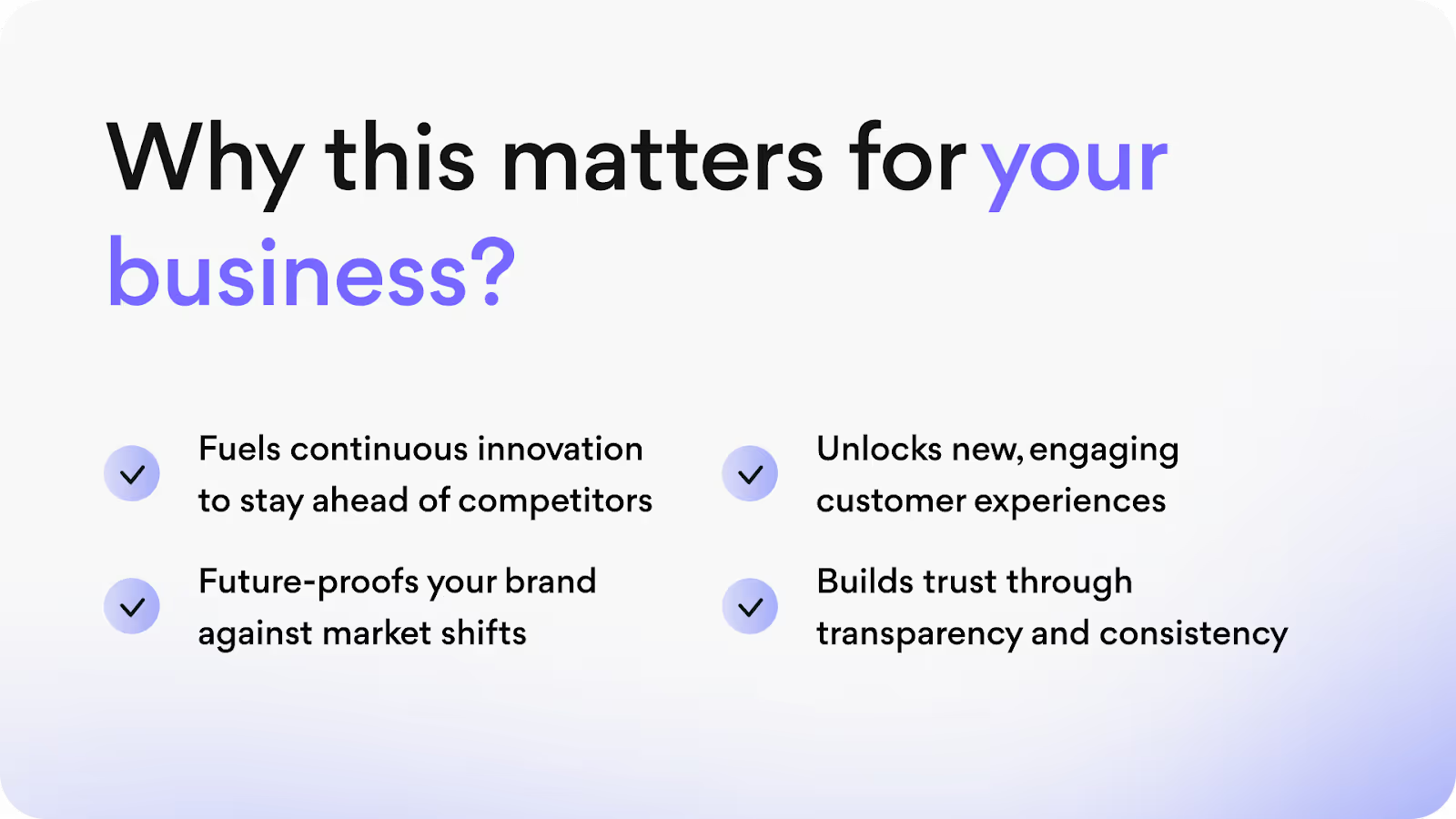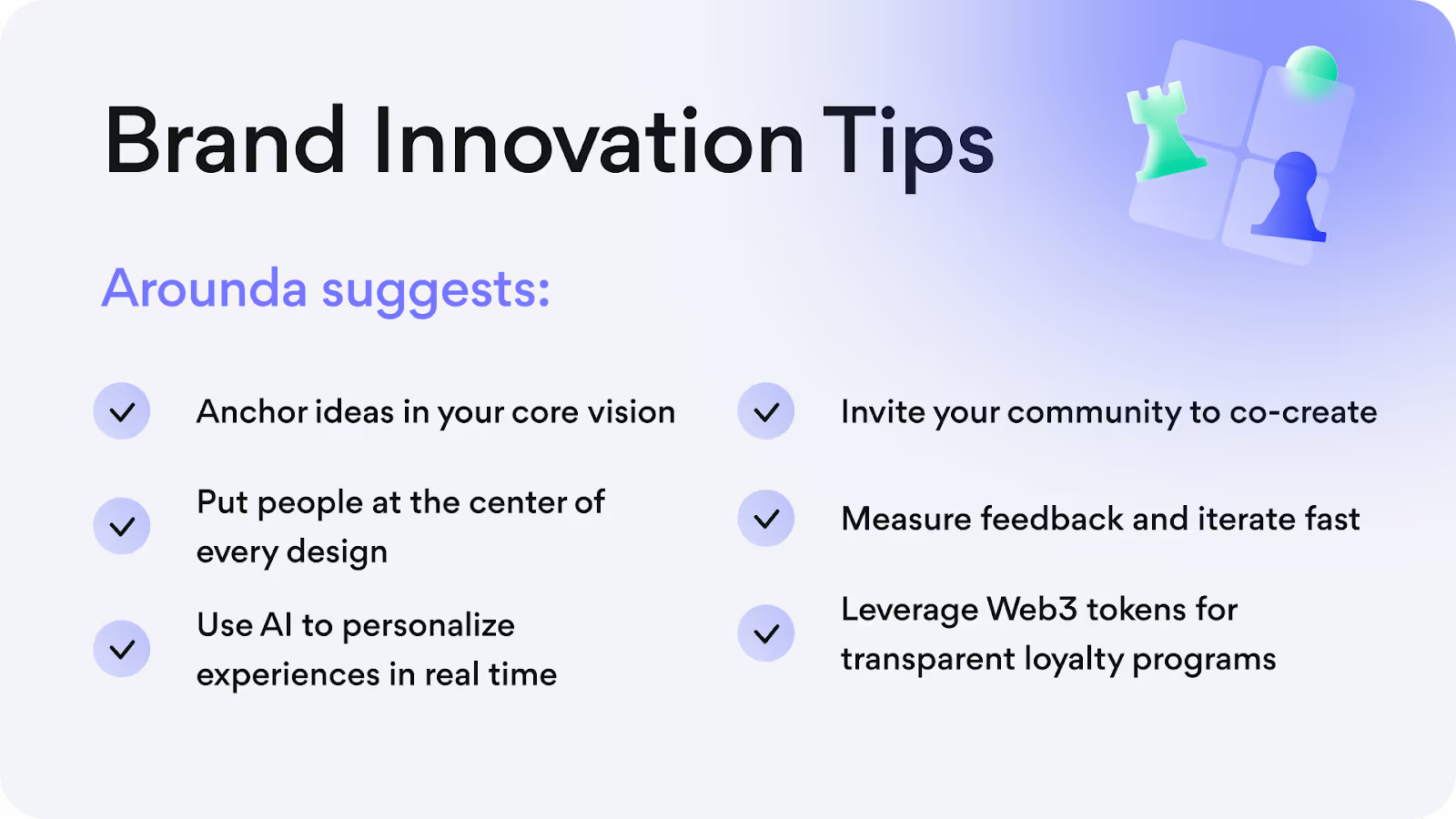If you are ready to enhance your web design with expert solutions, let’s talk!
Many people think innovation is about brainstorming new ideas and launching new products and services. But it is much more than that. Innovation includes more than a product: there are brand refreshes, packaging redesigns, promotional merchandising, optimal menu/portfolio composition, and advances in manufacturing, sourcing, and supply chain.
Companies that foster innovation outperform their peers 3.5 times. And that's true. Innovation is essential in today's multichannel environment, regardless of output. It motivates brand teams and consumers. It's essential for brands to continually develop new ideas aligned with their strategic objectives to maintain their character and grow their share of relevance and interest.
Businesses today need to find their way forward, or they will be left behind. Our team knows everything about brand innovation and can help you prepare for the future.

Understanding Brand Innovation in the Digital Age
Innovation and branding go hand-in-hand. Without the process of innovation, organizations cannot reinvent themselves, reconnect with their customers, or respond to market fluctuations. Any enterprise going through a brand update/rebranding must find a way to distance its product from the competition and remain loyal to its values. Innovative branding is about the way a company's products and branding are connected to the specific, timely needs of consumer interests while making sure competitors are left in its wake.
What Defines Brand Innovation Today?
Basically, it's all about finding new ways of differentiating yourself in an overcrowded market. Brand innovation can lead to revenue and market share, but your ultimate goal is to put a smile on the face of the customers. Brands are competing with new means today to get consumer attention, and consumers are being much more selective now; therefore, the expectation is a different brand experience. Branding innovation helps brands draw customers in while also building a strong and stable consumer experience through fresh and unique offerings.
Why AI and Web3 Are Changing the Branding Landscape
Web3 and AI trends are already changing the way a brand can develop a following. These technologies are shifting the landscape of how brands can interact with consumers, provide value, and gain brand loyalty from consumers. Specifically, AI marketing is expected to be $47.32 billion in 2025 and $107.5 billion by 2028 (expected growth of 36.6%). If brands want to succeed in the digital-first world post-Web3, where a decentralized internet leads to AI-based interactions allowing consumers to be more data-based and personal when interacting with brands, companies better start rethinking the way they brand.
AI's Role in Branding and Marketing
Even though AI has some apparent flaws, its flexibility makes it worthwhile at many stages of branding, from coming up with the initial plan to creative ideas and putting them into action.
AI is already changing sectors by processing massive volumes of data to inform better decisions. It assists brands in creating extremely personalized experiences, automates communications with consumers, and better shapes branding strategy with real-time data.
AI-Powered Customer Experiences
AI can analyze massive volumes of customer data, thereby personalizing customer experiences for a targeted audience. These applications make work easier, but can not replace the human touch and insight. AI could make branding easier and data-driven, while letting creatives and strategists work on fresh ways to connect with the audience.
Our team has assisted clients in transforming data-based concepts into finished products through the development of GT Protocol's AI-crypto assistant website.

Our AI web design services will help you optimize your brand's digital experiences so you can see the results.
AI-Generated Content and the Future of Brand Storytelling
AI is able to create quality text, photos, and films. Therefore, it enables brands to produce large distributions of personalized material that can be used to grow outreach while preserving brand integrity. AI-generated content can reflect the tone, style, and values of a brand, therefore providing cross-platform consistency.
Case Studies: How Brands Are Using AI to Innovate
Strategic innovation transforms how a brand delivers value to customers. AI solutions allow businesses to focus on many brand growth and relevance factors. The following AI tools underpin the innovation in branding.
Chatbots and Virtual Assistants in Brand Engagement
Chatbots' adaptability across the customer lifecycle makes them a significant tool for improving customer engagement, according to McKinsey & Company. Companies must establish their objective and confirm that the experience matches their corporate identity for chatbots to be effective.
Businesses using chatbots boost customer satisfaction and employee productivity. They personalize customer encounters, and 80% of users like it. Chatbots can answer client questions 24/7, unlike human operators. They help human agents handle more complex challenges by reducing their workload.
We're familiar with it, as we've recently designed the UX/UI for Sinta, an AI hiring assistant. We designed a branded chatbot experience that met user needs and the business goals, and created a seamless experience for our users. You can find out more about our SaaS design process here.
AI in Visual Identity and Design
Today, marketers use IA to generate images and train models with their visual identity to construct systems that can broadly grasp and replicate their graphical essence. Visual branding becomes more consistent, customized, and efficient across channels, formats, and markets.
The goal of the new creative ecosystem is to systematize brand visual logic, not just generate visuals. Models are fed logos, chromatic palettes, typographies, compositions, and real applications.
These systems learn to function autonomously inside visual frames without ongoing guidance.
The autonomous models maintain perfect brand consistency for all assets, which remain uniform across every communication channel. Our Brand Identity service will help you create essential frameworks and guidelines to train and maintain these systems so your visuals stay true to your unique vision.

AI-Powered Market Research and Consumer Insights
Daily data creation is 402.74 million terabytes.
Businesses may obtain consumer insights with AI-powered market research using machine learning, natural language processing, and predictive analytics.
However, AI-powered market research tools excel in certain areas:
- Automated surveys.
- Analysis of trends.
- Analysis of sentiment.
- Competitive intelligence.
- Visualizing data.
These insights can help brands create hyper-personalized marketing and implement proactive customer churn reduction strategies.
Web3 and Decentralized Branding
Web3, or decentralized web, is the next generation of the internet. Unlike Web2, where a few big companies own the data and platforms where interactions will occur, Web3 is based on blockchain technology, which allows users to have more ownership and control of their digital identities and assets.
Brands will no longer be hamstrung by a one-way relationship with their customers through companies like Facebook or Instagram to build their community. Rather, brands will have decentralized platforms to utilize that enable a community and allow brands to form more direct and transparent relationships with their customers.
Web3 gives your community control over gatekeepers so you can establish open relationships through decentralized systems and smart-contract management. Our Web3 design service develops user-friendly interfaces and unified visual designs that activate user-owned ecosystems.

NFTs, Digital Ownership, and Brand Loyalty Programs
Several years ago, NFTs were wildly popular. The chatter has died down, but marketers still value the fundamental technology. Web3 NFTs create ownership, access, and engagement.
These tokens enable digital ownership and exclusive experiences. NFT rewards are verifiable, tradeable, and unique, unlike company database point systems.
A B2B brand can issue NFT-based client certification credentials or tokenized access to invite-only forums or CEO roundtables. Use NFTs to prove your attendance at events, product feedback sessions, or early betas.
How Brands Are Monetizing Digital Spaces
Limited-edition NFTs that grant VIP access generate new revenue streams for brands. Entertainment companies open Metaverse pop-up shops for virtual and real merchandise preview and purchase, and creators create token-gated communities with paid, exclusive content. AI-powered chatbots personalize visitor journeys, and smart contracts automatically pay royalties on resales.
Modern website design converges both Web3 and AI into one cohesive piece of advanced UI/UX that not only opens up the ability to shape a website's layout based on user behavior but also provides hassle-free, one-click wallet crypto payment, as well as real-time personalized product suggestions. Brands can successfully retain customers through their combination of usable design and new and unique features that provide fun experiences.
The Future of E-Commerce in the Metaverse
As more people shop online, the eCommerce portion of the Metaverse is expected to be robust. Industry insiders expect it to reach $1 trillion by 2030 as companies launch and test new products in the virtual space.
Just picture entering a store in the Metaverse where your avatar can walk through the store, you can interact with AI shop associates, and you can try on virtual clothes that fit your digital self. Companies are utilizing the Metaverse to create interactive virtual marketplaces and dynamic virtual stores.
Gucci and Nike already have virtual marketplaces where customers can buy NFTs or other virtual things.

Integration of AI and Web3 in Brand Innovation
Integrating AI data intelligence with the decentralized trust of Web3 allows brands to deliver personalized experiences that are open, immersive, and scalable. AI algorithms deliver an unlimited amount of real-time personalized content and product recommendations to users based on their preferences. Meanwhile, blockchain and smart contracts ensure the authenticity of products and create verifiable ownership rights and functional transactions.
Decentralized Autonomous Brands (DABs)
A DAB is a blockchain-based, community-led brand governed by its members. In contrast to traditional brands, DABs use tokens or innovative contract-based platforms to let stakeholders — customers, creators, suppliers, and even fans — vote on crucial actions, campaigns, and projects.
DABs use blockchain technology, making financial, operational, and governance data public and verifiable.
AI in Web3-Driven Marketing Strategies
AI can analyze complex blockchain and off-chain data to determine the optimal marketing strategies. It can track ad clicks, social media activity, and community event participation.
It can correlate conversions and ROI to individual marketing efforts, helping marketers identify what works and what doesn't. AI in Web3 marketing will improve brand engagement and promotion.
Best Practices for Future-Ready Brand Innovation
Dynamic brands drive brand evolution. Companies achieve success through effective brand strategy optimization. They build foundational brand blocks through their commitment to future-ready branding features. The brand can achieve success in competitive situations by implementing future-ready methods.
Our services for Web3 brands include UI/UX development, web design, and brand identity creation to build interfaces that are intuitive, unified, and scalable. We developed complete app flows and high-fidelity wireframes for MYSO Finance before redesigning the online platform with light and dark modes and a single style guide and design system.

How to Leverage AI Responsibly
Without proper controls, AI tools can harm firms financially, legally, and reputationally. Google lost $100 billion in market value (9% stock decline) due to an error in its Bard chatbot in early 2023. In 2014, Uber was criticized for raising fares during a Sydney café siege due to increased demand. The corporation had to offer free trips to regain customer trust and reputation.
Arounda suggests AI branding best practices:
- External AI governance. Third-party algorithm audits are becoming more widespread and mandated by law, strengthening AI governance.
- Conformity to regulations. Companies must comply and undertake their due diligence or risk reputational damage and costly fines.
- Making an AI inventory. Creating a real-time inventory of AI systems can help reduce duplication, expedite risk management, and maximize compliance by readily identifying tools covered by different regulations.
Building a Decentralized Brand Presence
When you decentralize your brand operations, you transfer ownership and power to your community members.
Here's how to get started:
- Launch a Governance Token
- Create Token-Gated Access
- Build Open Feedback Loops
- Partner with Community Creators
- Maintain Transparent Reporting
Your brand will develop loyal stakeholders through audience empowerment, which enables them to shape and benefit from your brand's evolution.
Balancing Technology and Authentic Brand Storytelling
Avoid these 5 AI narrative traps when blending technology and human touch:
- Ignoring the Need to Modify AI Stories for Various Platforms.
- Disregarding Narrative Flow and Story Structure When Utilizing AI Tools.
- Putting too many AI-generated details into the story.
- Insufficient character development and depth when utilizing AI tools.
- Failing to Create Real Human Emotion.

Conclusion
A brand becomes memorable through the proper alignment of a clear vision with human-centered design and smart solutions. AI insights and Web3 abilities become part of a clear and intuitive UI/UX and unified visual identity. This enables you to stand out while fostering lasting trust and harmony with your audience.
We provide services to both startups and established brands that want a partner who listens to their art of storytelling and transforms that into meaningful experiences.
If you are seeking a partner who listens, cares about your story, and brings it to life through meaningful web design and branding services, then contact us. Together, we will create an experience that marries modern frameworks with your authentic self.














